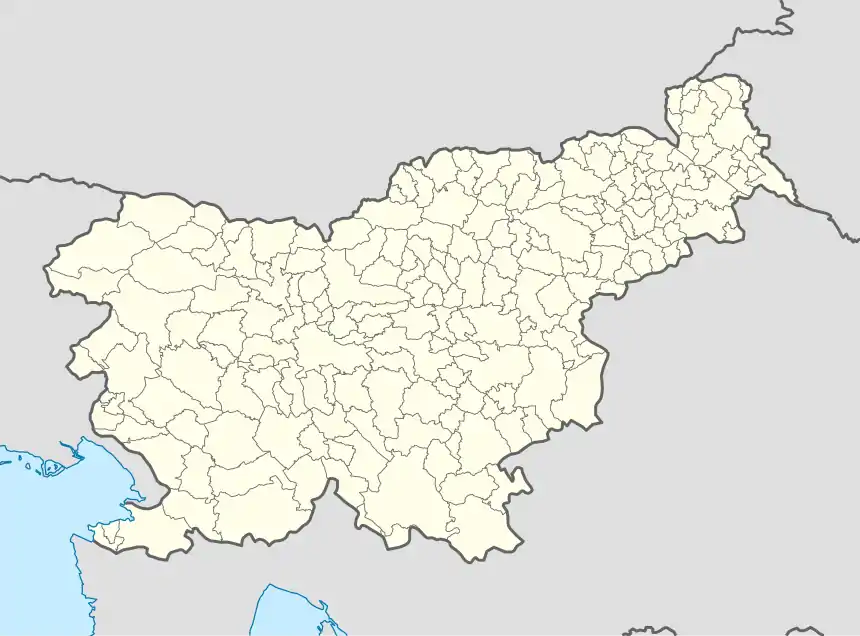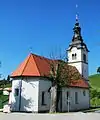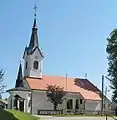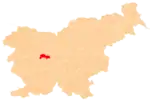Šentjošt nad Horjulom
Šentjošt nad Horjulom (pronounced [ʃɛnˈtjóːʃt nat xɔˈɾjúːlɔm, ʃənˈ-]; German: Sankt Jobst[2]) is a settlement in the Municipality of Dobrova–Polhov Gradec in the Upper Carniola region of Slovenia.[3] In addition to the main settlement, it also includes the hamlets of Kogel, Krvinet, Kurja Vas (Slovene: Kurja vas), Paradiže, Pišek, Potok, and Stavnik, as well as part of the hamlet of Suhi Dol.[4]
Šentjošt nad Horjulom | |
|---|---|
 | |
 Šentjošt nad Horjulom Location in Slovenia | |
| Coordinates: 46°1′54.01″N 14°13′33.39″E | |
| Country | |
| Traditional region | Upper Carniola |
| Statistical region | Central Slovenia |
| Municipality | Dobrova–Polhov Gradec |
| Area | |
| • Total | 7.56 km2 (2.92 sq mi) |
| Elevation | 619.1 m (2,031.2 ft) |
| Population (2002) | |
| • Total | 346 |
| [1] | |
Name
The name Šentjošt nad Horjulom literally means 'Šentjošt above Horjul'. The name Šentjošt is a fused compound of šent 'saint, holy' (< Latin sanctus[5]) and Jošt 'Judoc(us), Josse'[6] and is derived from the local church dedicated to the same saint.[7] The settlement was formerly known as Sveti Jošt nad Vrhniko,[8] Šentjošt nad Vrhniko[9] (literally, 'Šentjošt above Vrhnika'), or simply Šent Jošt. The name of the settlement was official changed to Šentjošt nad Horjulom in 1955.[10]
History
Archaeological finds in Šentjošt nad Horjulom include two silver bracelets from the early Slavic period.[4]
A part-time school was established in the rectory in 1810. A school building was built in 1900, and regular lessons started being held in 1923.[4]

Šentjost nad Horjulom was the site where the first Village Guard (Slovene: Vaška straža) was founded in Slovenia in July 1942.[11][12] The settlement's anti-communist orientation resulted in a number of Partisan reprisals. On 24 July 1942 the village was attacked by Partisan forces numbering as many as 400. The Partisans, who were fought off by the local militia, then attacked surrounding villages as they retreated, killing 20 people (nine married men, three women, five unmarried men, two unmarried girls, and one child) and burning 16 farms.[13] After the Second World War, there were almost no men left in the village, and the first postwar child was not born until 1955.[14] There is a shrine next to the cemetery in Šentjost nad Horjulom dedicated to the non-communist dead of the Second World War, and in the cemetery itself there is a cross dedicated to the Slovene Home Guard.
During the war, the German–Italian border crossed through what is now the northern part of the village's territory. There was a major checkpoint along the road between the hamlets of Pišek (on the Italian side) and Paradiže (on the German side), and the remains of the foundation of a border watchtower stand on the northwest slope of Kovček Hill (786 meters or 2,579 feet).[15]
Religious heritage
The religious heritage in Šentjošt nad Horjulom consists of two churches and several wayside shrines.
Churches
There are two churches in the settlement. The parish church is dedicated to Saint John the Evangelist. The date 1664 is carved into the church's door casing and its furnishings date from the first half of the 19th century.[4] The main altar dates from the end of the 18th century. It stands in the center of the village, south of Saint Josse's Church, and was declared a cultural monument in 2005.[16] A second church is dedicated to Saint Josse (Slovene: sveti Jošt).[17] It was first mentioned in written sources in 1401[18] and probably dates from the 13th century. One of the bells in the belfry was cast by the bell-maker Vivencius (active in the first half of the 14th century[19]) and is dated 1354.[4] The frescoes inside the church were produced by the Gorizia workshop between 1410 and 1420. The church was registered as a cultural monument in 2005.[18]
 St. John the Evangelist Church
St. John the Evangelist Church St. Josse's Church
St. Josse's Church
Shrines
In addition to the shrine at the cemetery dedicated to the non-communist dead of the Second World War, there are six wayside shrines in Šentjošt nad Horjulom registered as cultural heritage.
- The open chapel-shrine dedicated to the Virgin Mary dates from the beginning of the 20th century. It has four columns and contains a statue of the Virgin Mary. The exterior is painted. It stands in front of house no. 49 in the hamlet of Kurja Vas.[20]
- The shrine at the Benedet Farm (Slovene: Kapelica pri Bendetovih) stands west of the settlement near house no. 31. It is an open chapel-shrine dedicated to Our Lady of Peace. It was built after the Second World War.[21]
- The open chapel-shrine dedicated to the Sacred Heart was built after the First World War. It stands in the center of the village at the east end of the cemetery.[22]
- An open chapel-shrine dedicated to Saint John the Evangelist stands north of the village. It contains a wooden statue of the saint and was formerly a station used during processions.[23]
- There is an open chapel-shrine dedicated to Saint Joseph in the northwest part of the settlement. It stands above the main road at the Pišek farm, at Šentjošt nad Horjulom no. 43. It was built after the Second World War.[24]
- Another open chapel-shrine dedicated to Saint Joseph stands in the southern part of the settlement. It was built after the First World War and contains a statue of Saint Joseph. It has a semicircular arch accentuated with a stone.[25]
 Shrine to the Virgin Mary in the hamlet of Kurja Vas
Shrine to the Virgin Mary in the hamlet of Kurja Vas Shrine below Šentjošt nad Horjulom
Shrine below Šentjošt nad Horjulom Shrine in Šentjošt nad Horjulom
Shrine in Šentjošt nad Horjulom
Notable people
Notable people that were born or lived in Šentjošt nad Horjulom include:
Gallery
 The hamlet of Kurja Vas
The hamlet of Kurja Vas The hamlet of Paradiže
The hamlet of Paradiže
References
- Statistical Office of the Republic of Slovenia
- Leksikon občin kraljestev in dežel zastopanih v državnem zboru, vol. 6: Kranjsko. 1906. Vienna: C. Kr. Dvorna in Državna Tiskarna, p. 118.
- Dobrova–Polhov Gradec municipal site
- Savnik, Roman (1971). Krajevni leksikon Slovenije, vol. 2. Ljubljana: Državna založba Slovenije. pp. 434–435.
- Bezlaj, France. 2005. Etimološki slovar slovenskega jezika, vol. 4. Ljubljana: Slovenska akademija znanosti in umetnosti, p. 32.
- Keber, Janez. 1988. Leksikon imen. Celje: Mohorjeva družba, p. 223.
- Snoj, Marko. 2009. Etimološki slovar slovenskih zemljepisnih imen. Ljubljana: Modrijan and Založba ZRC, pp. 409–410.
- Kropej, Monika. 2001. Karel Štrekelj: iz vrelcev besedne ustvarjalnosti. Ljubljana: Založba ZRC, p. 133.
- Vrišer, Sergej. 1976. Baročno kiparstvo v osrednji Sloveniji. Ljubljana: Slovenska matica, p. 213.
- Spremembe naselij 1948–95. 1996. Database. Ljubljana: Geografski inštitut ZRC SAZU, DZS.
- Voglar, Dušan (ed.). 2001. Enciklopedija Slovenije, vol. 15. Ljubljana: Mladinska knjiga, p. 411.
- Čepič, Zdenko, Damijan Guštin, & Dejan Vončina. 2005. Podobe iz življenja Slovencev v drugi svetovni vojni. Ljubljana: Mladinska knjiga, p. 393.
- "Obletnica strahot pri Št. Joštu." 1943. Domoljub: slovenskemu ljudstvu v poduk in zabavo 56(29) (4 August) p. 3. (in Slovene)
- Veseli kristjani in neobremenjeni Kraševci. Mladina 14 (6 April 2012) (in Slovene)
- Stolp kot opomin na kruto razmejitev / A Tower as a Reminder of a Cruel Demarcation. Information sign posted at the foot of Kovček Hill.
- Slovenian Ministry of Culture register of national heritage reference number ešd 2449
- Družina RC Church in Slovenia journal site
- Slovenian Ministry of Culture register of national heritage reference number ešd 2451
- Vivencius. Slovenski biografski leksikon. (in Slovene)
- Slovenian Ministry of Culture register of national heritage reference number ešd 17194
- Slovenian Ministry of Culture register of national heritage reference number ešd 17196
- Slovenian Ministry of Culture register of national heritage reference number ešd 17197
- Slovenian Ministry of Culture register of national heritage reference number ešd 17198
- Slovenian Ministry of Culture register of national heritage reference number ešd 17199
- Slovenian Ministry of Culture register of national heritage reference number ešd 17193
- Slovenski biografski leksikon: Samotorčan Josip (in Slovene)
External links
 Media related to Šentjošt nad Horjulom at Wikimedia Commons
Media related to Šentjošt nad Horjulom at Wikimedia Commons- Šentjošt nad Horjulom official website
- Šentjošt nad Horjulom on Geopedia
